By: debbie lynn elias
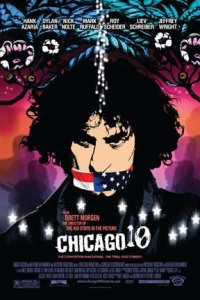 Ingenious. Innovative. Imaginative. Informative. Visionary. Vibrant. Appropriated. Historical. Educational. Stimulating. Timeless Captivating. Energetic. Explosive. Relevant. Constitutional. Patriotic. Yippicentric. This, is CHICAGO 10.
Ingenious. Innovative. Imaginative. Informative. Visionary. Vibrant. Appropriated. Historical. Educational. Stimulating. Timeless Captivating. Energetic. Explosive. Relevant. Constitutional. Patriotic. Yippicentric. This, is CHICAGO 10.
The time 1968. The Tet Offensive was launched in January 1968, striking not only Vietnamese targets, but the US Embassy in Saigon. 550,000 troops were in Viet Nam. 1,000 soldiers were killed each month. America had suffered casualties in excess of 30,000. In February, 3 Black students were killed and 27 wounded at South Carolina State University when fired upon by state troopers. In March, US military stormed the village of My Lai, killing 300 unarmed civilians. Martin Luther King was assassinated. Columbia University students held a protest in which 150 students were injured and 700 arrested. Phil and Daniel Berrigan set fire to 378 draft files in a parking lot. On June 5, Robert F. Kennedy was assassinated. Richard Nixon received the Republican Party nomination for President. Abbie Hoffman and Jerry Rubin were sitting in their apartment talking about doing something in Chicago during the Democratic Convention. And then “Boom! They create one of the biggest pieces of political theater ever staged on U.S. soil.”
During the 1968 Democratic Convention, peaceful protestors headed by Hoffman and Rubin, were denied permits for their “sit ins” and demonstrations during Convention week. As a result, they went head to head with the Chicago Police Department who waged a week long terrorization of the protestors culminating in tear gas filled riots witnessed by the entire country live on ABC, CBS and NBC. As should come as no surprise, the government needed an explanation and a few scapegoats for this heinous display and thus held accountable eight of the most vocal activists, ultimately bringing them to trial a year later. Abbie Hoffman and Jerry Rubin were counter-culture yippies. David Dellinger, a pacifist. Tom Hayden and Rennie Davis, one of Truman’s economic advisors, were co-founders of the Students for a Democratic Society. John Froines and Lee Weiner were followers, not leaders, while Bobby Seale a co-founder of the Black Panthers only went to Chicago that fateful week for 48 hours to deliver a speech in place of Eldridge Cleaver. These are the faces that helped shape a large part of this nation’s history.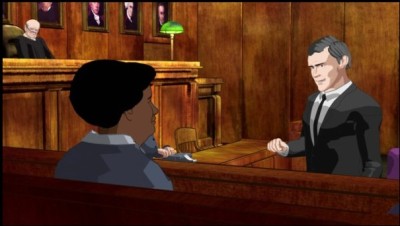
I remember 1968. I remember the images flashing across the black & white tv in our rec room. The convention. The park. The hippies and yippies. Police. Politicians. Peace activists. All coming together in a riotous clash in Chicago. A subsequent trial I later learned about in high school, college and ultimately, ad nauseum in law school, reading trial transcripts of the “Chicago 7” – Hoffman, Rubin, Dellinger, Davis, Hayden, Froines, Weiner, and for a time, the 8th member of circus troupe, Seale, as well as defense counsel William Kuntsler and Leonard Weinglass (both of whom round out the Chicago 10 thanks to their contempt citations issued during trial), not to mention the ringmaster Judge Julius Hoffman, and his sidekick, prosecutor Thomas Aquinas Foran. Writer/director Brett Morgan wasn’t born until the 1980’s and missed out bearing witness to the events and the lunacy that played such a large part in America’s history, but it is a time that clearly inspires him to this day.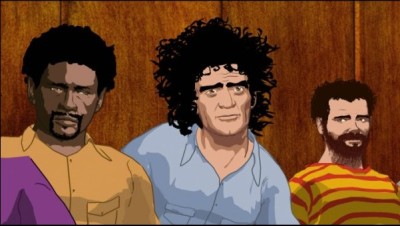
CHICAGO 10 is the vision of Brett Morgan; a vision that incorporates archival film footage culled from 180 hours of 16mm film, 14,000 photos, several hundred hours of audio tape and interviews, a 23,000 (yes, twenty-three thousand) page court trial transcript, newspaper archives, previously undiscovered audio trial tapes, courtroom drawings and various other media, laced with motion-capture animation of the trial, and all edited with light saber precision by the masterful Stuart Levy into what can only be described as the “ultimate narrative film.”
As Morgan describes it, “The genesis for the film started with a conversation I had with Greg Carter my producer. The US had just invaded Afghanistan and there was a lot of talk about invading Iraq. And Greg had said, ‘You know, what’s wrong with everyone? Why isn’t anyone out protesting? When I was young, we had the Chicago 7, Abbie Hoffman, Jerry Rubin. Man, those guys were rock stars. They were my heroes.’ And he goes “What do you think about doing a film about them?” And I’m like, about what? And he goes, ‘Ya know the trial. The riot thing.’ And I don’t think he realized at the moment how challenging it would be to intertwine the trial with the convention.”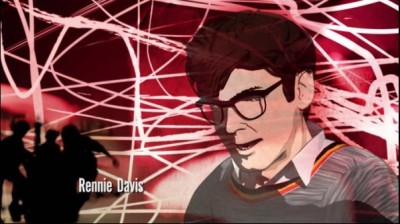
Rather than devise a film based on faded memories or dead guys, or opt for a heavy dramatization, Morgan took the novel approach of exposing this part of history and culture to a new generation through a fresh perspective – personifying the subject by using actual archival footage interspersed with animation of the trial. Animation? It was Abby Hoffman himself that inspired Morgan to use animation to depict the trial, having described the trial “as a cartoon show.” Even Judge Hoffman viewed his courtroom as grand theater. And what better way to celebrate the yippicentric tone of the film than with animation. To retain historical integrity and accuracy, trial animation scenes are then reinforced with live action counterparts creating a “revolutionary aesthetic. . . that captured that youthful energy of that moment in time.”
Keenly observing, “Most social change in this country is generally brought about by young people. So let them see the face of their peers on the screen.” Thus, the basis for no interviews with survivors of the day; use only current music; and go to some of today’s finest actors to voice the animations of the Chicago 10.
In one of his final appearances, Roy Scheider provides the voice for 78 year old Judge Julius Hoffman, a man that makes one wonder why he wasn’t removed from the bench ages earlier. Scheider is a dead ringer for Hoffman, a voice for which there were no known recordings until Morgan discovered some virgin audio tapes of the trial thus allowing he, and Scheider, to breathe real life into the character. Hank Azaria does double duty doing perfect mimicry of both Abbie Hoffman and Alan Ginsberg while Mark Ruffalo is amazing as Jerry Rubin. Although not a perfect voice match for attorney William Kuntsler (who was held in contempt by Judge Hoffman during trial) Liev Schreiber’s tonal qualities embody the essence of Kuntsler and his vocal trial modalities. And Nick Nolte is incomparable as the forever frustrated, slightly psychotic prosecutor Thomas Foran, goading not only Judge Hoffman to beyond egregious conduct but energizing an already electrifying Abbie Hoffman. The voicing is seamless with not only the archival footage but with the trial animation. In law school, the Chicago 7 trial was a primary case study in my constitutional law classes. I had read the trial transcripts then. As eye opening as reading the transcripts and actually bearing witness to the lunacy that was occurring during that trial in that courtroom was, to actually hear the testimony as delivered by this fine group of actors with the superb voicing and inflections exhibited in this film, puts an entirely new spin on the legal case itself and even my own interpretation of it.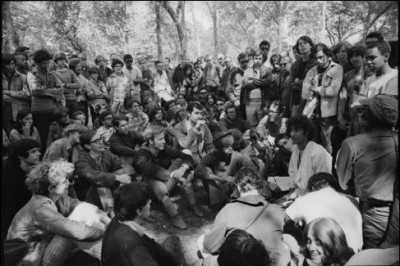
Key to the success of this film is Morgan’s use of motion capture for the animation. Not satisfied with 2D, motion-capture allows for computer sensors to be hooked up to one’s body, fed to a computer and the actual human movements digitized for animation thus solidifying the trial depiction with the archival footage. Morgan himself was a subject for a majority of the motion capture work, including playing Judge Hoffman. In fact, in order to achieve the realism of a decrepit 80 year old he put weights on his arms, shoulders, neck and head to achieve the Judge’s actual physicality.
Continuing with his theme of appropriation and yippification, Morgan knew, “I was never going to use the actual recordings of the 60’s. My original idea was to do new versions of 60’s music. Appropriate it. [Like the film], appropriate all the media and then spit out this new thing.” But, as is typical in low budget independent film, “we ran out of time or money or budget and ended up recording new stuff and licensing stuff that existed.” Thus, the soundtrack is graced with performances by Eminem, Funkadelic, Steppenwolf, Rage Against the Machine, Beastie Boys and Black Sabbath, all serving as enticement to today’s youth.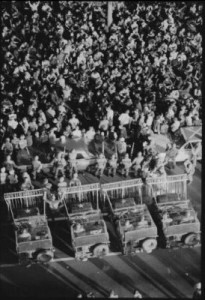
Something I have never mentioned in all these years if the film’s poster. The one for CHICAGO 10 warrants mention. It was designed by the late great digital artist Jeremy Blake. Blake committed suicide this past summer, after he found his wife or girlfriend of 12 years dead in their apartment. Known for his colorscopes with “Punch Drunk Love” and album covers too numerous to count, this poster was the last thing he did before his death. As noted by Morgan, “If you look at the poster, it’s an incorporation of 60’s iconography, but you can see that it’s rendered as something contemporary. That was kind of what the film was about.”
It is enthralling and refreshing to see Brett Morgan have the impetus to take explosive, constitutionally relevant and somewhat forgotten events such as these and re-energize them, bringing them all to the forefront for an entirely new generation. By using archival film footage, photos and audio and allowing the actual story to unfold in real time with the real players is not only compelling and engaging, but so timely and so critical to today’s society.
With CHICAGO 10, Morgan not only reminds those of us from the day, but opens up a crucial part of American history to an entirely new generation and it couldn’t be at a more appropriate time. Just look at the here. The now. This film is also a sad commentary on us as a people and a nation. We haven’t moved forward even one iota in 40 years. For every step forward in 1968, we have taken 10 back. Where is Abbie Hoffman when we need him? Thankfully, we have Brett Morgan and CHICAGO 10 to remind and inspire.
Abbie Hoffman and Alan Ginsberg – Hank Azaria
Jerry Rubin – Mark Ruffalo
David Dellinger & David Stahl – Dylan Baker
Thomas Foran – Nick Nolte
Judge Julius Hoffman – Roy Scheider
William Kuntsler – Liev Schreiber
Leonard Weinglass – Himself
Written and Directed by Brett Morgan. 100 min












